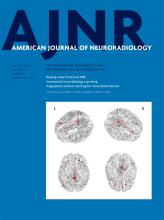Index by author
Wang, Y.
- FELLOWS' JOURNAL CLUBInterventionalYou have accessPrimary Angioplasty without Stenting for Symptomatic, High-Grade Intracranial Stenosis with Poor CirculationY. Wang, Y. Ma, P. Gao, Y. Chen, B. Yang and L. JiaoAmerican Journal of Neuroradiology August 2018, 39 (8) 1487-1492; DOI: https://doi.org/10.3174/ajnr.A5708
Thirty-five patients with high-grade, symptomatic intracranial stenosis and poor antegrade flow, treated with intracranial angioplasty without stent placement from January 2010 to December 2016, were retrospectively reviewed. The main outcomes included the changes in antegrade flow and residual stenosis and any stroke or death within 1 month. The average preprocedure stenosis was 88%. The immediate, average postprocedure stenosis rate was 25%, and the average postprocedure stenosis rate at last angiographic follow-up was 35%. The primary end point of major stroke or death at 30 days was observed in 1 patient (1/35, 2.9%), and no patient had intraprocedural complications. The authors conclude that primary balloon angioplasty was an effective treatment option for symptomatic intracranial stenosis with a high risk of stroke.
Wang, Z.
- FunctionalOpen AccessResting-State Functional MRI: Everything That Nonexperts Have Always Wanted to KnowH. Lv, Z. Wang, E. Tong, L.M. Williams, G. Zaharchuk, M. Zeineh, A.N. Goldstein-Piekarski, T.M. Ball, C. Liao and M. WintermarkAmerican Journal of Neuroradiology August 2018, 39 (8) 1390-1399; DOI: https://doi.org/10.3174/ajnr.A5527
Warne, R.R.
- EDITOR'S CHOICEPediatricsYou have accessThe Bone Does Not Predict the Brain in Sturge-Weber SyndromeR.R. Warne, O.M. Carney, G. Wang, D. Bhattacharya, W.K. Chong, S.E. Aylett and K. MankadAmerican Journal of Neuroradiology August 2018, 39 (8) 1543-1549; DOI: https://doi.org/10.3174/ajnr.A5722
MR imaging of 139 children presenting with port-wine stain and/or Sturge-Weber syndrome between 1998 and 2017 was evaluated by 2 pediatric neuroradiologists for marrow signal abnormality and pial angioma and other Sturge-Weber syndrome features. Groups were divided into port-wine stain-only (without intracranial Sturge-Weber syndrome features) and Sturge-Weber syndrome (the presence of cerebral pial angioma). In the port-wine stain-only cohort, 78% had ipsilateral bony changes and 17% had no intraosseous changes. In the Sturge-Weber syndrome cohort, 84/99 had associated port-wine stain, 91% had bony changesipsilateral to the port-wine stain or had no bone changes in the absence of port-wine stain, and 77% had bony changes ipsilateral to a cerebral pial angioma. The authors conclude that intraosseous marrow changes are strongly associated with facial port-wine stain. No significant association was found between pial angioma and bone marrow changes.
Wei, X.
- Head & NeckOpen AccessApplication of Reduced-FOV Diffusion-Weighted Imaging in Evaluation of Normal Pituitary Glands and Pituitary MacroadenomasM. Wang, H. Liu, X. Wei, C. Liu, T. Liang, X. Zhang, C. Jin, X. Li, Q. Sun, H. Jiang and J. YangAmerican Journal of Neuroradiology August 2018, 39 (8) 1499-1504; DOI: https://doi.org/10.3174/ajnr.A5735
Weinstock-guttman, B.
- Adult BrainYou have accessImpact of Focal White Matter Damage on Localized Subcortical Gray Matter Atrophy in Multiple Sclerosis: A 5-Year StudyT.A. Fuchs, K. Carolus, R.H.B. Benedict, N. Bergsland, D. Ramasamy, D. Jakimovski, B. Weinstock-Guttman, A. Kuceyeski, R. Zivadinov and M.G. DwyerAmerican Journal of Neuroradiology August 2018, 39 (8) 1480-1486; DOI: https://doi.org/10.3174/ajnr.A5720
Widjaja, E.
- PediatricsYou have accessThalamocortical Connections and Executive Function in Pediatric Temporal and Frontal Lobe EpilepsyN. Law, M.L. Smith and E. WidjajaAmerican Journal of Neuroradiology August 2018, 39 (8) 1523-1529; DOI: https://doi.org/10.3174/ajnr.A5691
Williams, L.M.
- FunctionalOpen AccessResting-State Functional MRI: Everything That Nonexperts Have Always Wanted to KnowH. Lv, Z. Wang, E. Tong, L.M. Williams, G. Zaharchuk, M. Zeineh, A.N. Goldstein-Piekarski, T.M. Ball, C. Liao and M. WintermarkAmerican Journal of Neuroradiology August 2018, 39 (8) 1390-1399; DOI: https://doi.org/10.3174/ajnr.A5527
Winegar, B.
- SpineYou have accessClinical Utility of a Novel Ultrafast T2-Weighted Sequence for Spine ImagingM.B. Keerthivasan, B. Winegar, J.L. Becker, A. Bilgin, M.I. Altbach and M. SaranathanAmerican Journal of Neuroradiology August 2018, 39 (8) 1568-1575; DOI: https://doi.org/10.3174/ajnr.A5713
Wintermark, M.
- FunctionalOpen AccessResting-State Functional MRI: Everything That Nonexperts Have Always Wanted to KnowH. Lv, Z. Wang, E. Tong, L.M. Williams, G. Zaharchuk, M. Zeineh, A.N. Goldstein-Piekarski, T.M. Ball, C. Liao and M. WintermarkAmerican Journal of Neuroradiology August 2018, 39 (8) 1390-1399; DOI: https://doi.org/10.3174/ajnr.A5527
Wongsripuemtet, J.
- FELLOWS' JOURNAL CLUBFunctionalYou have accessPreoperative Mapping of the Supplementary Motor Area in Patients with Brain Tumor Using Resting-State fMRI with Seed-Based AnalysisJ. Wongsripuemtet, A.E. Tyan, A. Carass, S. Agarwal, S.K. Gujar, J.J. Pillai and H.I. SairAmerican Journal of Neuroradiology August 2018, 39 (8) 1493-1498; DOI: https://doi.org/10.3174/ajnr.A5709
Sixty-six patients with brain tumors were evaluated with resting-state fMRI using seed-based analysis of hand and orofacial motor regions. Rates of supplementary motor area localization were compared with those in healthy controls and with localization results by task-based fMRI. Localization of the supplementary motor area using hand motor seed regions was more effective than seeding using orofacial motor regions for both patients with brain tumor and controls. Bilateral hand motor seeding was superior to unilateral hand motor seeding in patients with brain tumor for either side. The authors conclude that in addition to task-based fMRI, seed-based analysis of resting-state fMRI represents an equally effective method for supplementary motor area localization in patients with brain tumors, with the best results obtained with bilateral hand motor region seeding.








